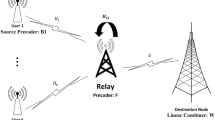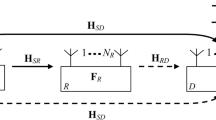Abstract
Relay beamforming is a key signal processing technique to mitigate interference in single and multiuser multiple input and multiple output (MIMO) wireless communication networks. In MIMO relay networks interference cancellation is an essential task of the study to get optimal network capacity. In this paper, the problem of interference resulted from leakage signal from desired signal for intended antenna, which causing interference to other antennas of the same user with multiple antennas is tackled. The criterion of signal to leakage plus noise ratio (SLNR) maximization is considered to design a vector by vector relay downlink precoding based on Fukunaga Koontz transform. This can control the interference among multiple antennas and maximize SLNR. However, matched filter beamforming is utilized at the relay receiving side that can increase output signal to noise ratio at the relay node. The channel state information of both the channel between source to relay and relay to destination is assumed at the relay node. The effectiveness of the proposed technique is studied and compared with conventional relay precoding techniques. Simulation is carried out in MATLAB environment using ideal channel conditions. This study demonstrates that, the proposed scheme for relay assisted MIMO networks can improve overall system performance in terms of ergodic capacity.









Similar content being viewed by others
References
Van Der Meulen, E. C. (1971). Three-terminal communication channels. Advances in Applied Probability, 3, 120–154.
Brown, T., Kyritsi, P., & De Carvalho, E. (2012). Practical guide to MIMO radio channel: With MATLAB examples. Hoboken: Wiley.
Vouyioukas, D. (2013). A survey on beamforming techniques for wireless MIMO relay networks. International Journal of Antennas and Propagation, 2013, 21.
Dohler, M., & Li, Y. (2010). Cooperative communications: Hardware, channel and PHY. Hoboken: Wiley.
Goldsmith, A. (2005). Wireless communications. Cambridge: Cambridge University Press.
Chandra, A., Bose, C., & Bose, M. K. (2011). Wireless relays for next generation broadband networks. IEEE Potentials, 30(2), 39–43.
Sanguinetti, L., D’Amico, A. A., & Rong, Y. (2012). A tutorial on the optimization of amplify-and-forward MIMO relay systems. IEEE Journal on Selected Areas in Communications, 30(8), 1331–1346.
Chen, F. (2013). Optimal design for MIMO relay system. Journal of Signal and Information Processing, 4, 91.
Cover, T., & Gamal, A. E. (1979). Capacity theorems for the relay channel. IEEE Transactions on Information Theory, 25(5), 572–584.
Wang, B., Zhang, J., & Host-Madsen, A. (2005). On the capacity of MIMO relay channels. IEEE Transactions on Information Theory, 51(1), 29–43.
Bolcskei, H., Nabar, R. U., Oyman, O., & Paulraj, A. J. (2006). Capacity scaling laws in MIMO relay networks. IEEE Transactions on Wireless Communications, 5(6), 1433–1444.
Shi, H., Abe, T., Asai, T., & Yoshino, H. (2007). Relaying schemes using matrix triangularization for MIMO wireless networks. IEEE Transactions on Communications, 55(9), 1683–1688.
Zhang, Y., Luo, H., & Chen, W. (2010). Efficient relay beamforming design with SIC detection for dual-hop MIMO relay networks. IEEE Transactions on Vehicular Technology, 59(8), 4192–4197.
Wang, Z., Chen, W., & Li, J. (2012). Efficient beamforming for MIMO relaying broadcast channel with imperfect channel estimation. IEEE Transactions on Vehicular Technology, 61(1), 419–426.
Wang, Z., Chen, W., Gao, F., & Li, J. (2011). Capacity performance of relay beamformings for MIMO multirelay networks with imperfect-CSI at relays. IEEE Transactions on Vehicular Technology, 60(6), 2608–2619.
Wang, Z., & Chen, W. (2013). Relay beamforming design with SIC detection for MIMO multirelay networks with imperfect CSI. Vehicular Technology, IEEE Transactions on, 62(8), 3774–3785.
Senaratne, D., & Tellambura, C. (2009). Performance analysis of channel inversion over MIMO channels. In Global telecommunications conference, 2009. GLOBECOM 2009. IEEE.
Sadek, M., Tarighat, A., & Sayed, A. H. (2007). A leakage-based precoding scheme for downlink multi-user MIMO channels. IEEE Transactions on Wireless Communications, 6(5), 1711–1721.
Saeid, E., Jeoti, V., & Samir, B. B. (2012). Efficient PA-SLNR linear precoding for multiuser multiple input multiple output system. Research Journal of Applied Sciences, Engineering and Technology and Technology, Maxwell Scientific Organization, 4(15), 2489–2495.
Sadek, M., Tarighat, A., & Sayed, A. H. (2007). A leakage-based precoding scheme for downlink multi-user MIMO channels. IEEE Transactions on Wireless Communications, 6(5), 1711–1721.
Oyman, O., & Paulraj, A. (2006). Design and analysis of linear distributed MIMO relaying algorithms. IEE Proceedings-Communications, 153(4), 565–572.
Primak, S., & Kontorovich, V. (2011). Wireless multi-antenna channels: Modeling and simulation (Vol. 28). Hoboken: Wiley.
Adam, E. E. B., Yu, L., Haruna, R., & Mohammed, A. A. (2014). Performance analysis of best relaying protocol selection with interferences at relays. Radioengineering, 23(2), 721.
Zheng, W., & Lin, Z. (2012). A new discriminant subspace analysis approach for multi-class problems. Pattern Recognition, 45(4), 1426–1435.
Zhang, S., & Sim, T. (2006). When fisher meets Fukunaga–Koontz: A new look at linear discriminants. In 2006 IEEE computer society conference on computer vision and pattern recognition (Vol. 1, pp. 323–329).
Author information
Authors and Affiliations
Corresponding author
Rights and permissions
About this article
Cite this article
Saand, A.S., Jeoti, V. & Saad, M.N.M. Efficient Beamforming by SLNR Maximization for Dual-Hop Relay Assisted MIMO Network. Wireless Pers Commun 87, 645–661 (2016). https://doi.org/10.1007/s11277-015-2624-7
Published:
Issue Date:
DOI: https://doi.org/10.1007/s11277-015-2624-7




